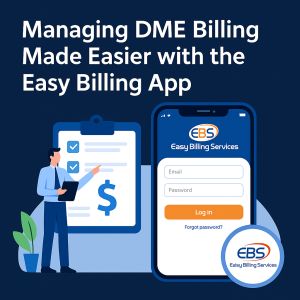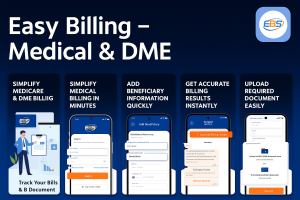Coding systems are very important in healthcare for effective revenue management and regulatory compliance. As medical billing moves into the year 2025, all professionals across the board are asking themselves, what are DME codes? DME codes are important in billing durable medical equipment and assuring providers of rightful reimbursement. In this ultimate guide, we look at everything DME codes entail: their definitions, their necessity, their application, major dos and don’ts, and good practices for application.
Understanding What Are DME Codes?
Durable Medical Equipment (DME) codes help with billing for items like wheelchairs and oxygen tanks. Eventually, every billing professional is going to think: what are DME codes? In essence, these codes standardize the description and categorization of durable medical equipment, providing a mechanism through which communication can be facilitated between providers and insurers without having to worry about claim denials.
DME codes are created to classify equipment based on certain criteria with respect to usage, type, and function. It assists in setting the reimbursement amount since each code is defined under a specific guideline as set by regulatory dues. The transition into 2025 has brought more refinements and updates to these codes, thus eliciting the requirement for billing specialists to be competent with the current information. With the evolving dynamics in healthcare policies, understanding what are dme codes? It is no longer an advantage but rather a necessity for compliance and timely payments.

DME Codes in Medical Billing
Coding is imperative for a healthcare provider’s revenue cycle. One of the frequently asked questions in this area is: what are DME codes for medical billing? This specialized coding aims to ensure that each piece of durable medical equipment is correctly coded for its intended use under the applicable specific reimbursement policies. Even slight inaccuracies on the billing experts’ part may lead to rejected claims and delayed payments. Therefore, they must keep abreast of coding changes.
DME billing is all about understanding the coding guidelines, payer requirements, and compliance requirements. Claims need to be adequately detailed to indicate how and why this equipment was necessary and used.
Navigating the DME Code List
The dme codes list is a fundamental resource for anyone involved in the issue of medical billing. This list constitutes the cornerstone whereby each code description and reimbursement rate are accounted for. The Dme code list helps billing staff verify their claims and confirm that the equipment is correctly coded. The list of codes is updated regularly in real-time for changes in healthcare policy and reimbursement structures; thus, it shall remain an indispensable tool knocking on the door of 2025.
Understanding the Dme code would require exploring not only its historical background but also the most recent changes. This dual way of consideration readily solves the ongoing question: what are dme codes? It also provides billers with the contextual gear they need going forward. An in-depth familiarization with the list aids in a snappy claim process, denial prevention, and revenue cycle health.
Medicare and Chiropractic Considerations
Apart from the regular DME coding, there are a lot more things that come into play while dealing with Medicare and the features of chiropractic. A simple example is understanding the details of a medicare code, which is crucial for providers serving mostly older clients. Medicare gives providers many instructions and payments, making it important for them to choose the right codes and document everything accurately.
In the same way, adding chiropractic treatment to the therapies yields a very different code. Most chiropractic practices employ a combination of services whereby each requires, on its own, the proper coding process. While chiropractic code is different from the common DME coding, principles of accuracy, compliance, and detailed documentation are quite the same.
They emphasize the importance for health professionals to regularly ask, “What are dme codes?” and apply this knowledge in their field to ensure each claim meets the strict standards of various payers.
Best Practices for 2025 in DME Billing
Going further and deeper into 2025, these best practices in dme billing should be bringing on board technological options and regulatory updates. An effective process comes from a clear understanding of what a coding framework includes, reinforcing the need to ask, “What are DME codes?”
Here are the best practices to consider:
- Stay Updated: Read coding manuals and regulatory agency updates regularly. Encourage continuous education and training sessions to ensure your team stays current on interpreting and using DME codes.
- Invest in Technology: Modern billing software keeps up to date with developments in DME coding. Reducing automation human errors is very important at this stage.
- Cross-Reference Claims: Develop internal audits and peer reviews to ensure that each claim is handled according to new standards. Incorporating regular checks can catch discrepancies early.
- Engage with Experts: See if you can consult coding experts or attend an industry workshop. A more extensive exposure to what are dme codes? From various perspectives can enrich your overall billing strategy.
- Optimize Your Workflow: Integrate guidance documents from payer policies and government updates into your billing process to adopt the latest operating standards. For example, a robust approach to DME Billing can streamline operations and optimize claim accuracy overall.
These practices will reduce claim denials as much as possible and improve revenue cycle management’s overall efficiency.
Bringing It All Together
The medical billing scenario is an ever-changing one, and with the new ways of coding and reimbursement, all willing health professionals must stay informed. Throughout this entire guide, the question has always resurfaced: what are dme codes? And we have discussed its importance from different angles. Right from understanding the basic definitions, trying to work with a detailed dme code list, or discussing specific issues such as the medicare code and chiropractic code, each of these viewpoints has reinforced a need for precision and clarity.
By regularly asking, What are DME codes? You ensure billing practices stay accurate and compliant. With the right tools, knowledge, and processes, you can confidently manage claims and protect your practice’s financial health.
Take control of your billing process and ensure compliance in 2025 with expert support from Easy Billing Services LLC®. Whether you’re refining your coding strategies or need guidance navigating the updated DME code list, our team is here to help you maximize revenue and reduce claim denials.
Get in Touch Today:
- Call: 877-306-2906
- Email: info@easybillingservices.com
Frequently Asked Questions:
What exactly are dme codes?
DME codes are standardized identifiers for durable medical equipment that ensure accurate billing and reimbursement.
Why are DME codes used for medical billing?
They streamline the billing process by matching equipment with reimbursement criteria, reducing errors and claim denials.
How do I use the dme code list?
The dme code list provides detailed descriptions and guidelines for each code, ensuring compliance and accuracy.
How do medicare and chiropractic codes affect billing?
Selecting the correct medicare code and chiropractic code is essential for proper DME billing and meeting regulatory standards.
Why is it important to understand dme codes in 2025?
Staying updated on dme codes is vital for adapting to regulatory changes and maintaining efficient billing practices.









